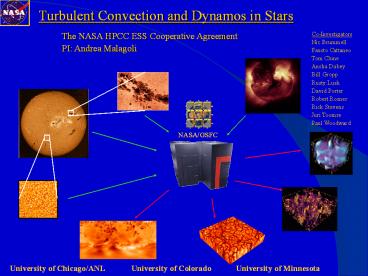The%20NASA%20HPCC%20ESS%20Cooperative%20Agreement - PowerPoint PPT Presentation
Title:
The%20NASA%20HPCC%20ESS%20Cooperative%20Agreement
Description:
The Piecewise Parabolic Method coupled with a parabolic solver. ... HelioSeismology. Granulation and Sunspots. X-ray images. The NASA HPCC ESS CAN ... – PowerPoint PPT presentation
Number of Views:39
Avg rating:3.0/5.0
Title: The%20NASA%20HPCC%20ESS%20Cooperative%20Agreement
1
Turbulent Convection and Dynamos in Stars
The NASA HPCC ESS Cooperative Agreement PI
Andrea Malagoli
Co-Investigators Nic Brummell Fausto Cattaneo Tom
Clune Anshu Dubey Bill Gropp Rusty Lusk David
Porter Robert Rosner Rick Stevens Juri
Toomre Paul Woodward
NASA/GSFC
University of Chicago/ANL University
of Colorado University of Minnesota
2
Turbulent Convection and Dynamos in Stars
Performance Milestones PI Andrea Malagoli -
University of Chicago
All our Scientific Application codes have
achieved the 100 GigaFlops performance milestone
on the Cray T3E-1200 testbed at NASA/GSFC
- MHD-PPM Convection (MHD-PPMC) 195.8 GFlops
- The Piecewise Parabolic Method coupled with a
parabolic solver. - Solves the equations of compressible
(magneto)hydrodynamics - (MHD) with radiative diffusion.
- Hybrid PseudoSpectral (HPS) 167.0 GFlops
- Uses hybrid finite-difference and pseudospectral
spatial derivatives - and a second order time stepping method.
- Solves the equations of compressible
(magneto)hydrodynamics - (MHD) in a rotating plane.
- MHD PseudoSpectral (MPS) 160.0 GFlops
- Uses a fully pseudospectral method with
Runge-Kutta time stepping. - Solves the equations of incompressible
(magneto)hydrodynamics - (MHD) in a triply periodic domain.
3
Observations data obtained by current NASA
missions reveal that complex, highly time
dependent phenomena are taking place on the
surface of the Sun. These phenomena are related
to the vigorous interaction between turbulence,
rotation and magnetic fields in the Suns
Interior. Simulation-based models on NASAs
High Performance Testbeds are used to interpret
observations data and to build detailed models of
the Suns interior. These models play a
fundamental role in both the interpretation of
current missions data and in driving the design
of all future missions
SOLAR B
TRACE
SOHO
4
Turbulent Convection and Dynamos in Stars
Simulations PI Andrea Malagoli - University of
Chicago
Convectively driven solar dynamo simulations have
been carried out using our Milestones codes on
NASAs T3E testbed. AUTHORS Fausto Cattaneo
and Anshu Dubey - UofC MACHINE Cray T3E-1200 at
NASA/GSFC CODE MHD PseudoSpectral RESOLUTION
512x512x97
High resolution simulations are used to study the
origin of magnetic fields in the quiet
photosphere of the Sun Images from the
simulations can be compared with observational
images The model suggests that small flux
elements are generated locally by dynamo action
associated with the granular and supergranular
flows
Vertical magnetic field
Temperature
Temperature fluctuations near the upper boundary
in a numerical simulation of convectively driven
dynamo action. Dark tones correspond to cold
(downflowing) material
Vertical component of the magnetic field near the
upper boundary. Dark and light tones correspond
to fields of opposite polarity
5
Turbulent Convection and Dynamos in Stars
Simulations PI Andrea Malagoli - University of
Chicago
Simulation data have higher resolution than
observational data. Artificial blurring can be
used to compare and interpret observational data
AUTHORS Fausto Cattaneo and Anshu Dubey
MACHINE Cray T3E-1200 at NASA/GSFC CODE MHD
PseudoSpectral RESOLUTION 512x512x97
6
Numerical simulations of convectively driven
dynamos
- Magnetic elements generated by dynamo action
display considerable structural complexity - Limited resolution can lead misleading
interpretation of true structure of magnetic
elements - in terms of oversimplified flux tube models
- Numerical simulation can help the development of
more realistic models and the design - of high resolution instruments for the
detection of small-scale magnetic elements
coarse grained
original
Detail of bipolar magnetic element. The figure
shows an area of 200x200 pixels.
Same image convoluted with a Gaussian filter with
12 pixels FWHM. Even a modest amount of coarse
graining leads to substantial loss of
information.
Simulations by F. Cattaneo A. Dubey

